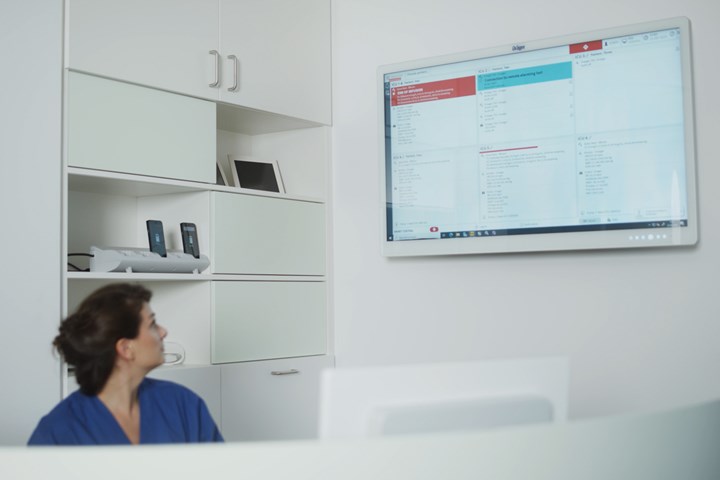Country selector

Corporate
Country Selector: Corporate

An innovative solution leveraging seamless interoperability to enhance alarm management in the ICU. By reducing noise and improving workflow efficiency, our Silent ICU contributes to a more comfortable patient environment and a more effective workspace for caregivers.

Excessive noise and disturbances in the ICU can negatively impact patient rest, recovery and well-being. It can also increase stress and alarm fatigue for clinical staff, with the risk of missing critical alarms. This can lead to a range of problems for patients, staff, and the effective running of the ICU, including:

With active alarm management at its core, the Silent ICU solution, jointly developed by Ascom, Dräger and B. Braun, is designed to help reduce noise pollution and alarm fatigue to provide a better healing environment, patient care and working environment.
The Silent ICU solution seamlessly, automatically, and securely transfers data between devices and management systems based on international standards such as ISO/IEEE 11073 SDC.
The solution enables alarms to be transferred to the Ascom-distributed alarm system. Alarms are visualized on one or several dashboards that can be located at the nurse station and where teams need them. In addition, actionable alarms are simultaneously routed to the right caregiver at the right time. Meanwhile, at the bedside, the medical device alarms remain silent, which significantly reduces noise levels in the ICU.
Alarms from medical devices can be reliably distributed to central dashboard(s) and mobile devices in a Confirmed Distributed Alarm System according to ISO/IEC 60601-1-8:2020 (CDAS). Each caregiver receives clinical alarms for their patients, with full clinical context, enabling them to make quick decisions and help to improve their workflow efficiency, wherever they are in the unit.
Caregivers can be confident that alarms will be attended to. In case of unavailability, the alarm is automatically redirected to a backup team member. A clear redirection chain ensures no alarm goes unanswered, making a positive contribution to patient safety.
Medical device alarms can be silenced at the patient’s bedside while ensuring reliable distribution to caregivers. In addition to reducing noise for patients and family, this feature allows the doors of the ICU rooms to be closed, creating an even quieter environment and preventing infection control.
If the network connection is lost, caregivers are notified and medical devices revert to audible alarms, ensuring patient safety until connectivity is restored.
Support the transition from your existing to new medical devices at the pace decided by the hospital. Ascom integrates legacy and new devices, supporting silencing capability, by providing uniform workflows in the alarm management solution.
From a few beds to several units, or multiple hospitals.
The solution uses the ISO/IEEE 11073-SDC standard for secure, authenticated, and encrypted data transfer within the hospital’s on-premise system.

SDC (Service-Oriented Device Connectivity) is revolutionizing how medical devices and hospital IT systems communicate—securely, reliably, and across manufacturers. Built on the ISO/IEEE 11073 standard, SDC enables seamless, two-way data exchange, supporting smarter clinical decisions and safer patient outcomes.

As part of the European research program SASICU (Smart and Silent ICU), Ascom plays a significant role in making intensive care units smarter and quieter. Supported by the Innovative Health Initiative (IHI), the project seeks to mitigate alarm fatigue and improve clinical decision-making through seamless medical device interoperability. Ascom collaborates with partners, including Dräger and several prominent university hospitals across Europe, conducting two studies associated with this initiative.
One study, executed jointly with Erasmus Medical Center, Dräger, and B. Braun investigates the advantages of Silent ICU based on standardized interoperable medical technologies. Ascom's Silent ICU solution is designed to allowing the silencing of bedside alarms and evaluate alarm relevance based on clinical data, thereby fostering a tranquil patient environment while ensuring clinicians remain informed of actionable alerts.
By utilizing the SDC standard, Ascom aids in establishing an open and secure ecosystem that empowers healthcare professionals in their decision-making processes and enhances patient comfort and safety.
A further project at Universitair Medisch Centrum, Utrecht, centers on evaluating alarm significance and actionability through the utilization of intelligent algorithms implemented in Ascom solution.

There are good reasons why many hospitals dream of smarter, silent ICUs. One, they contribute to better patient outcomes. Two, they make for better, more efficient working environments for busy caregivers. That’s why Ascom is currently part of two high-level projects co-funded by the EU—projects devoted to bringing smarter, silent ICUs closer to reality. Learn more from Paolo Burchietti of Ascom’s Global Solutions team.


Acknowledgement
This project is supported by the Innovative Health Initiative Joint Undertaking (IHI JU) under grant agreement No. 101132808. The JU receives support from the European Union’s Horizon Europe research and innovation programme and COCIR, EFPIA, Vaccines Europe, EuropaBio, and MedTech Europe.
Disclaimer: Funded by the European Union, private members, and contributing partners of the IHI JU. Views and opinions expressed are those of the author(s) only and do not necessarily reflect those of the aforementioned parties. None of the aforementioned parties can be held responsible for them.